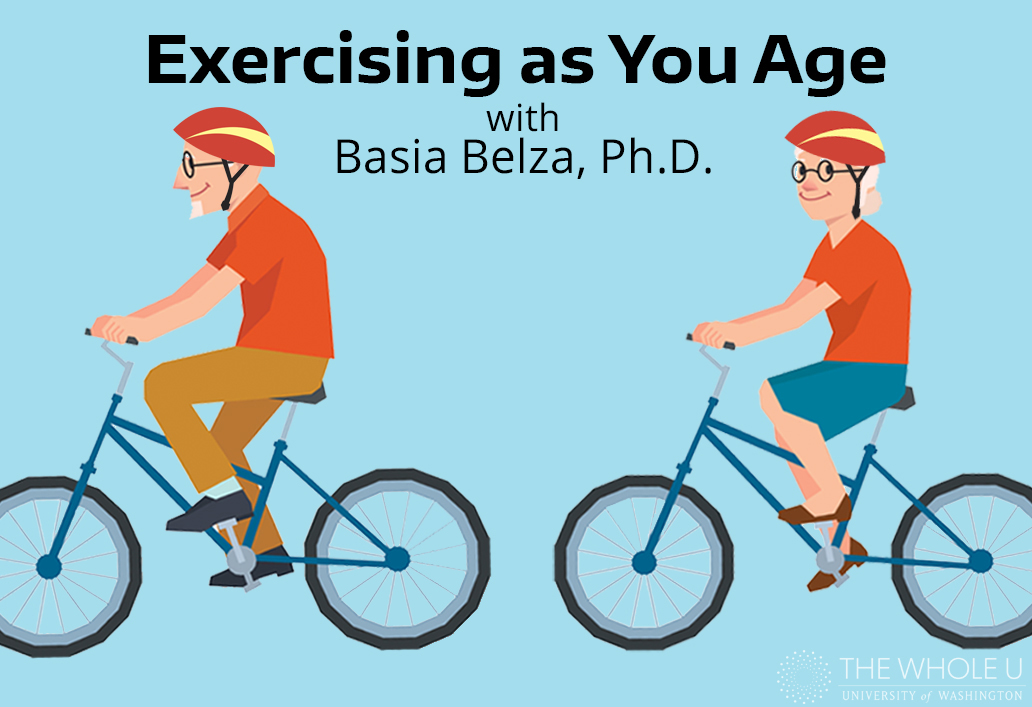
Exercising as You Age with Basia Belza
Who isn’t afraid of aging?
Kids hate growing up and grown-ups hate getting older. And yet, we can’t slow down time. Nor can we magically turn back the clock, despite the promises of late-night infomercials. Our best bet is to age healthily, and the best way to do that is to be active.
“Physical activity is the number one thing that all of us can do to promote our health,” said Basia Belza, the Aljoya Endowed Professor of Aging at the School of Nursing.
You know that fitness reduces your risk of cancer, diabetes, and cardiovascular disease. But it also helps you stay mentally alert. “When you talk to adults, one of their main concerns is staying sharp,’” Belza said. “The research supports that physical activity helps maintain brain health.”
So why aren’t you exercising? You’re too busy balancing work with kids and grandkids. You would rather unwind on the couch and watch TV. Or maybe you just don’t feel up to the task of working out anymore: most people lose 1-2 percent of muscle per year after they turn 50, and that makes lifting things — especially weights — harder than it used to be.
All of these are valid reasons to dread exercise. Belza has received attention from national media and government agencies for her research on making exercise less dreadful. In particular, she focuses on mall walkers — those people who go to shopping malls to get their steps in (check out her mall walking guide here).
Marching around the mall isn’t for everybody, but the principles of mall walking can be applied to any exercise program. Let’s take a look at why mall walking works.
1. No learning curve
Could you walk into a gym, sit down at the bench press, and bust out 15 reps? Could you lace up a new pair of running shoes and jog around your neighborhood without losing your breath? Maybe, maybe not. But you could definitely walk around a mall for half an hour. Try to think of other activities like that — stuff that requires no special skills and has no learning curve — but that still gets your legs moving and heart pumping.
2. Accessibility
Malls are everywhere. “They’re highly accessible to people regardless of socioeconomic status,” Belza said. If you drive, there’s plenty of parking. If you need a ride, a bus stop is nearby. Think of other areas that you can repurpose for fitness. The Woodland Park Zoo has a senior walking program, and Xfinity Arena in Everett opens its ice rink up to walkers five days a week.
3. No-cost
Malls don’t charge a cover. It’s like a free gym. Think about where you can exercise for free, whether it’s lifting weights in your garage, cycling at a local park, or scaling the stairs with your coworkers (I’ve seen people in Roosevelt Commons do laps around the parking garage during their break). That said, cost can be a deterrent for some and a motivator for others. Some people find that paying for a gym makes them utilize it, lest they feel the money has been wasted. Find out what motivates you.
4. Routine
Mall walkers know exactly when they’re going to walk. Bellevue Square Mall, example, is open to them on Mondays, Wednesdays and Fridays from 8:00 to 9:30 a.m. (the program is run by Overlake Medical Center and staffed by YMCA employees). Set aside a regular time to exercise and create a calendar event. Don’t cancel it unless there’s an emergency. If you’re too tired in the morning and too busy after work, find a way to move at lunchtime. A short workout is better than nothing. “Start with a 10-minute walk,” Belza suggested. If you log 10 minutes of exercise three times a day, you’ve reached the 30 minutes of recommended daily exercise.
5. Group-Based
“Routine is important and convenience is important,” Belza said, “but socialization is probably the most important thing.” Mall walkers often pair up or form groups, and those who walk alone are still at least in the company of others (many stick around to drink coffee and swap stories afterwards).
6. Easy to track
Directories are scattered throughout malls. Besides showing you where Banana Republic is, they help you track how far you’ve walked. Logging your progress can help you stick to an exercise routine. Count the blocks you walk to your bus in the morning or the flights of stairs you climb when you get to work.
Don’t expect to become an avid exerciser overnight. “People don’t automatically take on new behaviors,” Belza said. It takes time. Be patient with yourself and remember that incremental progress is better than no progress. Every mall walker knows that life moves one step at a time.
This series is a collaboration between The Whole U and UW Medicine. Articles will explore health how-to’s, wellness trends, and specific parts of the body. Got a topic you’d like us to cover? Send an email to Matt at The Whole U.